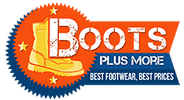Why Comfort Matters When Selecting Work Boots for Men
Share
Selecting the right work boots is crucial for anyone spending long hours on their feet, especially in demanding environments. While durability and safety are commonly discussed, comfort is often overlooked, yet it plays a pivotal role in overall foot health and work efficiency.
Understanding the Role of Comfort in Work Boots
Comfort is the first thing you should consider when selecting work boots because it directly impacts your productivity and health. Uncomfortable boots can lead to foot pain, fatigue, and even injuries over time, all of which can detract from your performance at work. When you’re wearing comfortable boots, you feel more energized and focused, allowing you to concentrate better on your tasks. This is especially important in physically demanding jobs where your performance relies heavily on your ability to move and act swiftly.
Another crucial aspect to consider is the link between comfort and safety. When your feet are aching, it distracts you from important safety protocols, and this is where accidents can occur. Much like wearing a well-fitted helmet or gloves, choosing comfortable work boots is a proactive step in ensuring your safety at work. Did you know that poor footwear is a leading cause of workplace injuries related to slips, trips, and falls? This statistic alone highlights the importance of investing in comfort, not just for personal well-being but also for maintaining workplace safety.
The Anatomy of Comfortable Work Boots
To ensure comfort, pay attention to various parts of the boot, such as cushioning, arch support, and the flexibility of the sole. These factors help in reducing strain and absorbing shock as you move around throughout the day. The midsole, in particular, plays a significant role in shock absorption. Materials like polyurethane are excellent at providing both comfort and durability. Additionally, the boot’s outsole is crucial for maintaining grip and stability, ensuring that you remain grounded, literally, on any surface.
Let’s not forget about the importance of the boot’s interior design. A well-cushioned footbed not only enhances comfort but also provides essential support for your arches, which can prevent conditions like plantar fasciitis—a common ailment among those who spend long hours on their feet. Proper arch support helps distribute your body weight evenly across the foot, minimizing pressure points and reducing fatigue. It’s these thoughtful design elements that transform a standard boot into a comfortable companion for the workday.
Materials and Design Features for Enhanced Comfort
The choice of materials—such as leather, Gore-Tex, or other breathable fabrics—can greatly affect comfort levels. Additionally, features like padded collars, moisture-wicking linings, and ergonomic fits contribute to a more comfortable wearing experience. Leather, for instance, is a preferred material due to its durability and ability to conform to the foot’s shape over time, offering a personalized fit. On the other hand, more modern materials like Gore-Tex provide excellent waterproofing while allowing for breathability, making them ideal for challenging work environments where moisture is an issue.
The technological advancements in work boot design have led to innovations that enhance comfort remarkably. Consider features like anti-fatigue technology found in some boot brands, which provide targeted support to key zones of the foot, actively working to reduce the strain that accumulates throughout the day. Moisture-wicking linings keep the feet dry, reducing the risk of blisters and other foot ailments. By investing in these state-of-the-art features, you’re not just buying a pair of boots; you’re investing in your long-term health and comfort on the job.
How to Properly Fit Work Boots for Optimal Comfort
Getting the right fit involves more than just measuring your foot size. Consider aspects like width, ankle support, and allowance for socks. A well-fitted boot reduces the likelihood of blisters, calluses, and other discomforts. It’s recommended that you try on boots in the afternoon, as feet tend to swell over the course of the day. This ensures that your boots will be comfortable even during long, demanding work shifts.
When fitting work boots, you should always consider the type of socks you intend to wear. Thick, cushioned socks can significantly affect the fit, so it’s best to bring them along while trying on new boots. Moreover, pay attention to heel slip; a small amount is normal, but excessive movement can lead to blisters. A good test is to see if you can lace the boots tightly without discomfort, ensuring the foot is snug yet not constricted. These small details play a huge role in ensuring that your boots fit like a glove, ready to offer unwavering comfort from the first hour to the last.
The Long-Term Benefits of Comfortable Work Boots
Investing in comfortable work boots can have lasting benefits, including improved posture, reduced risk of chronic foot conditions, and enhanced overall well-being. These advantages underscore why comfort should never be compromised in work boot selection. Proper posture alignment facilitated by comfortable boots translates into less stress on your back and joints, effectively lowering the chances of long-term wear and tear or injuries.
Think about the broader implications of maintaining good foot health. Without chronic aches and pains, you’re inadvertently reducing healthcare costs associated with managing foot-related health problems. Furthermore, with improved comfort and support from your boots, downtime due to foot-related issues is minimized, resulting in better productivity and job satisfaction as you can stay focused on your tasks.
The Importance of Prioritizing Comfort in Work Boots
Choosing the perfect pair of work boots goes beyond just ticking off a checklist of features. Prioritizing comfort can significantly enhance your work experience, helping you stay focused, productive, and, most importantly, pain-free during long shifts. Remember, the right pair of boots is an investment in your well-being and success on the job.

